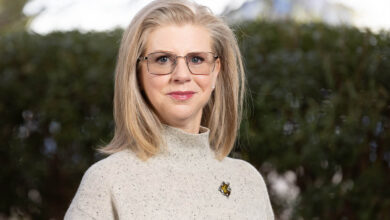
The Art of Food
UArizona Museum of Art’s Largest Exhibit in Over a Decade
By Valerie Vinyard
The University of Arizona Museum of Art’s new exhibition looks good enough to eat.
“The Art of Food,” a buffet of 109 pieces of food-themed art, will debut Oct. 24 at the UAMA and run through Mar. 20.
In the exhibition are works by Andy Warhol, Roy Lichtenstein and a bevy of other post-World War II artists. The collection will be featured across four of the UAMA’s galleries and outdoors. It will include prints, lithographs, watercolors, photos and sculpture.
This will be an impressive kickoff tor the museum, which had been closed in recent months because of construction. In fact, “The Art of Food” will be the UAMA’s largest exhibition in more than a decade.
Curator Olivia Miller, who has been at UAMA for almost 10 years, is excited about the array of artists that will be featured in the exhibit.
“People should come to it because we all have a connection to food,” Miller said. “It’s not only necessary to sustain our bodies but everyone has a connection to food. Food is essential to community and culture.”
The museum can thank the Jordan Schnitzer Family Foundation for access to the pieces.
Schnitzer, a lifelong art lover, first visited UArizona in 1970 over spring break. When he was in Tucson about three years ago, he invited Miller to visit Portland, Ore. to see his collection. As they sifted through thousands of works of art, Miller said the theme of food kept coming up.
“It seemed like the topic was perfectly connected to the community,” she said.
Schnitzer, who has more than 19,000 works in his collection, said that this exhibit showcases “the best of the best artists of the last 50 years.”
“Deliciously seductive, the images are all known to us,” he said. “They’re very welcoming. After you’re looking at them, the work grabs you.”
“Art has brought out the creative genius in people,” he added. “Artists in particular are always chroniclers of our time, and that is different than other art forms.”
Schnitzer is president of Harsch Investment Properties, a Portland-based real estate investment company that owns and manages office, multi-tenant industrial, multi-family and retail properties in six western states, including Arizona. Harsch owns more than 657,200 square feet of commercial real estate in Tucson, including a 157,500 square-foot distribution center and regional office near the Tucson International Airport. The company is also a Sun Corridor Inc. Chairman’s Circle investor.
During a recent phone interview, Schnitzer said the exhibit will rival offerings from museums in New York City. “Art has always been and is the best of what we do in society,” he said. “The visual arts have always been a predominant, cultural form.”
One area in the gallery will focus on beverages, including one featuring Warhol’s Perrier bottles, a Jasper Johns untitled Coca-Cola print and Damien Hirst’s “The Last Supper,” a series of huge screen prints.
Of the Hirst work, Miller said he appreciates its double meaning and aesthetic. “It looks like pill packaging,” she said. “It looks like you’re looking at a prescription medicine, but it’s different foods instead of medicine.”
She described another fun piece by pop artist Jonathan Seliger called “Fresh,” a mixed media sculpture of a recreated Table Talk pie made out of cotton and aluminum powder and mylar.
“When you walk in and see it, you’ll think it’s real,” she said. “It has a one-word title that is so ironic. It’s this fresh pie at this bargain price. I think it speaks to American consumerism, where how do we define the word ‘fresh’ and how that definition can be really fluid. It’s that lure of the bargain, we’re attracted to the sale.”
Few topics are as collective as food. “Whatever geopolitical issues there are, everyone eats,” Schnitzer said.
In addition to the impressive collection, a variety of talks over the coming weeks will be presented, including one by a German studies professor who will discuss “Sexy Salad and Manly Meat: Are we really what we eat?”, plus marketing and leadership professors who will speak about local food movements and how they’re marketed. There will be special tours given of Tucson Village Farm and Mission Garden.
The Art of Food will also feature numerous interdisciplinary programs with both campus and community partners to highlight the unique food heritage of Tucson as a UNESCO City of Gastronomy, as well as the cutting-edge food research happening at UArizona.
Portland artist Malia Jensen will give a talk on Nov. 9 at the museum. She has two pieces in the exhibit – “Butterscape,” which features a gold-painted stick of butter sitting on top of a plate, and “Untitled,” a block of salt that has been carved in the shape of a breast and is part of a larger project called “Worth Your Salt.”
A book titled “The Art of Food” also is planned and will include essays by notable art critics along with art museum staff.
Customarily, art museums are required to cover the cost of a custom crate, shipping and an administrative fee or loan fee when borrowing a collection. Schnitzer’s foundation, however, will cover all costs except shipping.
“Art is the last bastion where hopefully every student on this campus goes to see this exhibit,” Schnitzer said. “What they see is unique to them. Art museums are not for some elitist few, they’re for everybody.”
“THE ART OF FOOD”
Oct. 24-Mar. 20
University of Arizona Museum of Art
1031 N. Olive Road
Cost: $8 general admission;
$6 seniors 65 and older and groups of 10 or more, and free for museum members, students with ID, UArizona faculty and staff, American Alliance of Museums members, active military personnel, visitors with a SNAP card or Tribal ID, and children.
Information at (520) 621-7567





